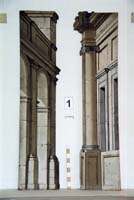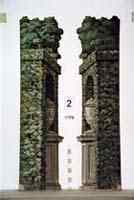
The scenery for the baroque theatre stage is made up of several parts. The wings were built in parallel rows alongside the stage, which is closed above by a suffitto and a flat screen at the back, which could be divided into several layers by using a system of so-called cut-through curtains. All the scenery parts were flat and illustrated. It was only on rare occasions that these basic parts were added to by using other flat pieces of scenery directly on the stage. This decorated scheme together with the system of changing scenes had been used for a long time till the 19th century.
The scenes for the new Litomyšl theatre were painted in 1797 by the Viennese painter Joseph Platzer, a leading creator of theatre scenes and the author of the decorations for the Nostic Theatre in Prague (1781) and in Vienna Theatres. His scenes were in place at the first run of Mozart's Don Giovanni. Platzer painted sixteen pieces of scenery for the Litomyšl theatre (however, the origin of some pieces is in doubt), which allow a very wide choice from many different environments and a lot of decorative supplements. These pieces of scenery are the only items of Platzer's work to be preserved, and make up one of the most valuable collections of its kind in Europe.


The interiors are the most richly endowed. We can find here several richly decorated halls (a Gothic hall with columns in front of the rear backdrop, a Blue “ancient” hall), a Prison (prison courtyard and cell), a Burger's room, an Office, a Coffee house, a Church, a Rustic room and an Armorer's house.
The exterior scenes include a Forest (with the rare view with an ancient temple in the backdrop), a French garden (its backdrop was destroyed), two street views and a Beach scene. Some of the scenes were used in conjunctions with the same side scenery (the Rustic room and the Armorer's house). For the interiors two sets of suffitas were used - a pink drapery for the festinate halls and a beam ceiling for the rustic rooms-, for the exteriors there are sky-blue “air” suffitas. Some of the backdrops are split into the several layers by using so-called cut-through curtains, the Prison cell scenes have instead of a suffitas and side scenery just three arches in the form of a vaulted ceiling.

All the sceneries are decorated with details covering the most diverse genres, apart from the festive halls, which are still decorated with classical baroque perspectives (diagonal perspective “per angolo”), they move away from the baroque illusion and announce the first signs of romanticism and the realist decorations of the later period. The scenes for the blue and yellow rooms are very similar to the paintings in the castle parlors and it is possible that they were painted not by Platzer, but by Dominik Dvorák.



Platzer painted two drops curtains (preserved till today) for the Litomyšl castle theatre. There are some architecture motifs on both - the through view to the circle courtyard with colonade of the temple have been figured in the first one and the through view to the courtyard of palace with columns in the second one.
The fixed part of the stage in Litomyšl, except the portal, is a proscenium vault with draperies and vases at the sides and drapery consistent with suffitas of the festive halls.
The scenes that have been preserved to this day in the castle theatre (just a small sections were destroyed) have been stored in depositories in the Litomyšl castle. At
the research in fifties of the 20th century black-and-white photographs of the decorations were created, which were used as groundwork for making dummy copies of the theatre.


In the second half of the 20th century the scenes were partially restored and the scenes have been used just on rare occasions and just then for stationary positioning on the stage. All attempts to present them on more occasions to the public - as their artistic importance would demand - have so far failed. In 1993 the copies of the side scenery depicting the French garden and a view of the forest were made; for the future the copies of the other pieces of scenes should be made for use on the stage.
The Association Milislav has carried out the check-up and the photograph documentation most of the castle theatre scenes in terms of the grant CORA-PHI (the final part of the documentation will be probably ended on Spring 2002). The Association has continued with researches, which should make an original appearance of the decorations stage sets clear and their real usage in the castle theatre.
| 


